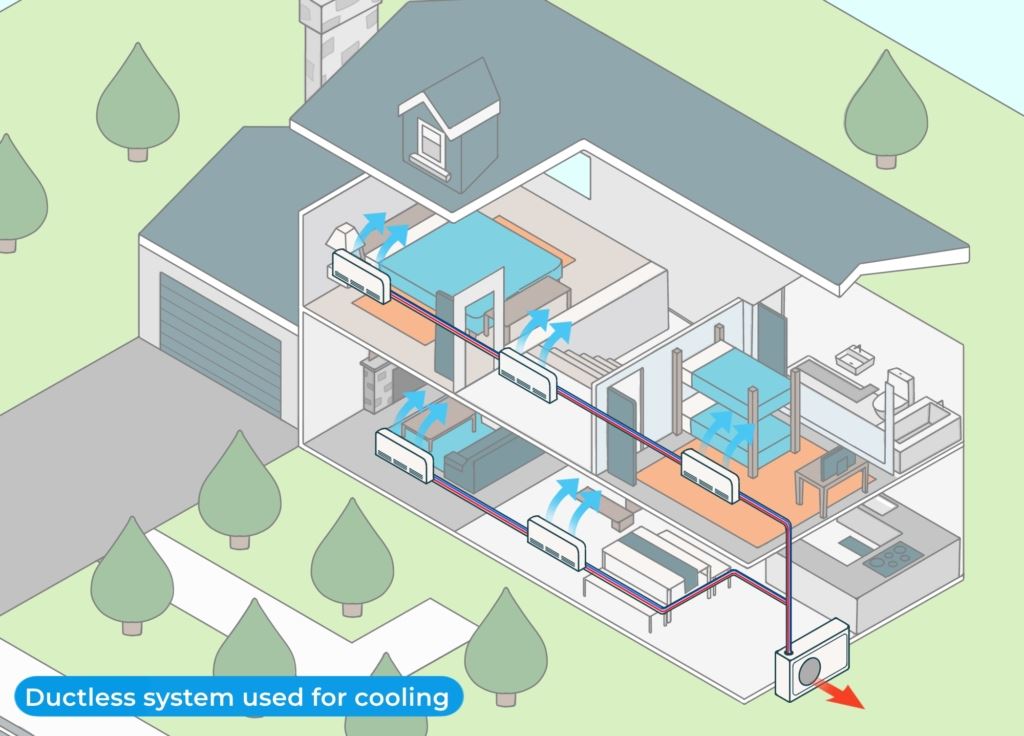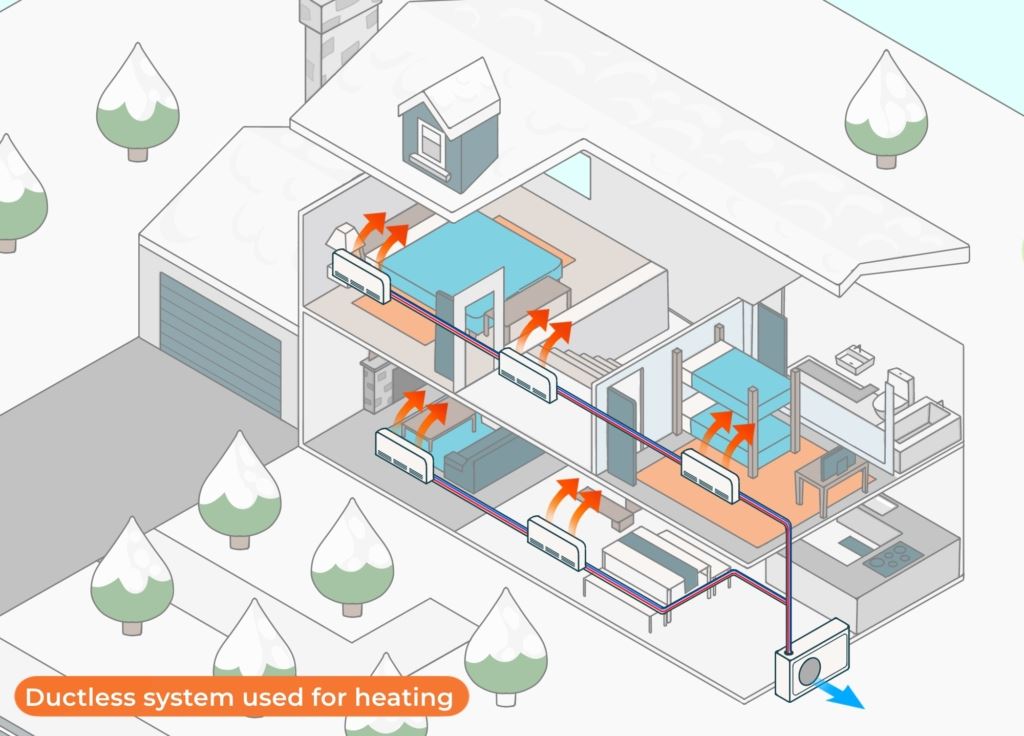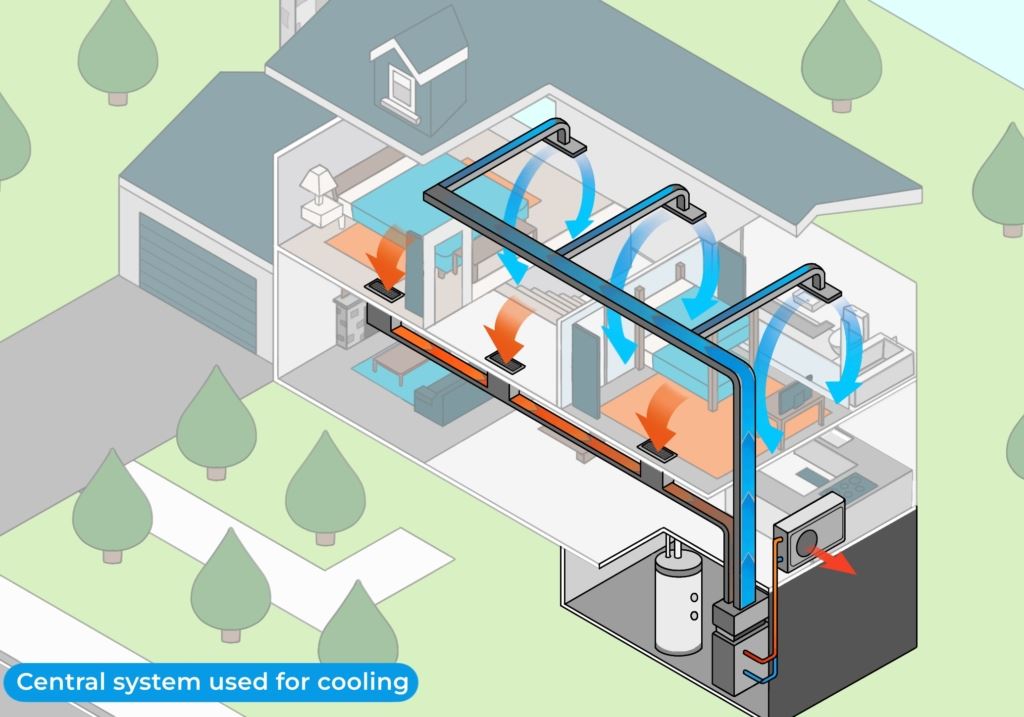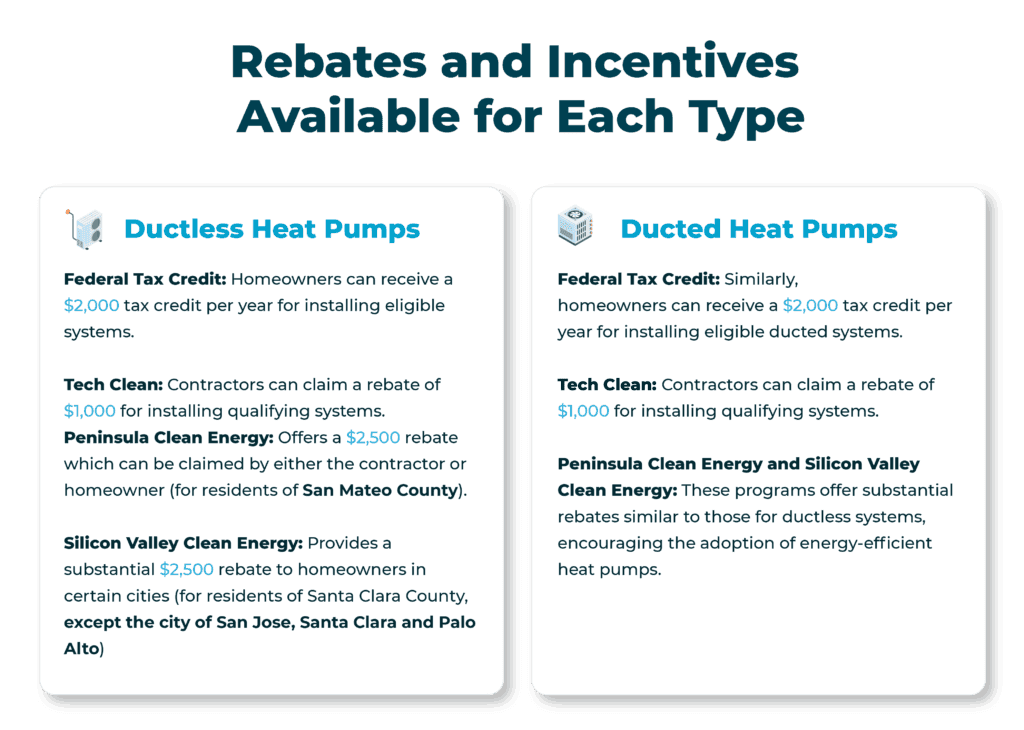
Imagine a device in your home that not only slashes your energy bills by up to 60% but also does its part in fighting climate change. This isn’t futuristic tech; it’s the heat pump, a system that’s rapidly becoming a household essential thanks to its exceptional energy efficiency and dual ability for heating and cooling. As heat pumps rise in popularity among eco-conscious and cost-saving homeowners alike, the decision between ductless and ducted types becomes more crucial.
Choosing the right heat pump is about more than just adjusting your thermostat; it’s about tailoring your home’s energy use to fit your lifestyle while optimizing for comfort and cost. Whether it’s the sleek, minimal intrusion of a ductless model or the comprehensive, whole-home comfort of a ducted system, making the right choice can significantly enhance your living environment. This article will guide you through the intricacies of both ductless and ducted heat pumps, helping you decide which system is best suited to meet the specific demands of your home and lifestyle.
Understanding Heat Pumps
Heat pumps are ingenious devices that play a crucial role in both warming and cooling our homes, but how exactly do they work? At their core, heat pumps operate on the principle of heat transfer, rather than generating heat directly. This method involves moving heat from one place to another. For instance, in winter, heat pumps extract heat from the outdoor air, water, or ground, and transfer it inside to warm your home.
Conversely, in the summer, the process reverses, with the system extracting heat from inside your home and releasing it outdoors to cool the interior.
This ability to reverse the flow of heat not only makes heat pumps exceptionally versatile but also incredibly efficient. Since they simply move existing heat rather than generate it by burning fuel, they use significantly less energy compared to conventional heating and cooling systems. This efficiency is a cornerstone of why heat pumps are favored in energy-saving initiatives globally.
Ductless Heat Pumps (Mini-Splits)


Definition and How They Work
Ductless heat pumps, or mini-splits, consist of an outdoor compressor/condenser and one or more indoor air-handling units. These components are connected by a conduit that houses your power cable, refrigerant tubing, suction tubing, and a condensate drain. Mini-splits work by extracting heat from the outside air—even during cold weather—and transferring it inside your home. For cooling, this process reverses, expelling heat from inside your home to the outdoors.
This system allows you to provide targeted heating and cooling to specific areas of your home without the need for extensive ductwork, making mini-splits an excellent choice for enhancing older buildings without existing ducts or for new additions where extending ductwork is impractical.
| Category | Pros | Cons |
| Energy Efficiency | High SEER and HSPF ratings save energy and reduce utility bills by 30-50% in California. | Less effective in large homes without multiple units, increasing cost and complexity. |
| Installation | Requires only a small hole in the wall, preserving home integrity. | Multiple units may be needed for full home coverage, raising initial costs and impacting interior aesthetics. |
| Flexibility | Independent control of each unit allows precise temperature management, reducing energy waste. | |
| Aesthetics and Space | Sleek, modern design can be integrated into home décor, saving space. | Indoor units might be more noticeable compared to hidden ductwork, depending on personal taste. |
Mini-splits offer a flexible and energy-efficient heating and cooling solution that is particularly suitable for homes in California, especially those with specific architectural styles or preservation needs. Their capability to provide zoned comfort control and operate quietly makes them a highly appealing option in the mild to moderate California climate.
Ducted Heat Pumps


Definition and Operation
Ducted heat pumps consist of an outdoor unit and a series of ducts that distribute heated or cooled air throughout your home. This system operates by extracting heat from the outside air, the ground, or water sources, and transferring it indoors. In cooling mode, it works opposite by removing indoor heat and releasing it outside, effectively cooling the interior. Ducted systems are seamlessly integrated into your home, using the existing pathways of ductwork to deliver temperature-controlled air to every room.
| Pros | Cons |
| Ideal for Homes with Existing Ductwork | Installation Can Be Expensive and Disruptive If Ductwork Is Not Present |
| Can Efficiently Heat and Cool Entire Homes | Potential for Higher Energy Loss Through Ducts |
| Maintains Consistent Aesthetics |
Ducted heat pumps offer a robust solution for whole-home climate control, especially suitable for your existing ductwork setup. While they provide a streamlined look and consistent temperatures throughout your home, it’s important to consider the potential challenges and costs, particularly if your home does not currently have ductwork installed. Regular maintenance and ensuring your ducts are well-sealed and insulated can help maximize the efficiency of a ducted system.
Comparative Analysis
When deciding between ductless and ducted heat pumps, it’s crucial to consider several factors, including installation costs, long-term savings, aesthetic impacts, suitability for different architectural styles and climates, and overall energy efficiency. Here’s a detailed comparison to help you weigh your options.
| Factor | Ductless Heat Pumps | Ducted Heat Pumps |
| Installation Costs | Generally lower, especially if there is no existing ductwork. Installation can be staged room by room. | Higher if ductwork needs installation or major modification. Costs are more manageable with existing ducts. |
| Long-Term Savings | Significant savings on energy bills due to high energy efficiency. | Potential for substantial savings, though slightly less than ductless if ductwork isn’t well-maintained. |
| Impact on Home Aesthetics | Units are visible within rooms but can be sleek and less obtrusive. Offers flexibility in placement. | Almost invisible once installed; only vents are visible, preserving the home’s interior aesthetic. |
| Suitability for Architectural Styles | Ideal for modern homes, renovations, or older homes without ductwork. Best in mild to moderate climates. | Suitable for homes with existing ductwork; offers uniform climate control. Effective in various climates. |
| Energy Efficiency | Higher SEER and HSPF ratings due to no duct-related losses. | Efficiency may be lower due to potential duct losses, but modern systems with improvements are competitive. |
| Examples and Statistics | Up to 60% savings in heating costs. SEER ratings commonly above 20, HSPF above 10. | Efficiency improvements and proper maintenance can mitigate energy losses through ducts. |
Case Studies and Real-World Applications
Ductless Heat Pumps
- A historic Victorian home in San Francisco successfully integrated a ductless system to avoid the disruption that installing ductwork would entail. The homeowners installed multiple indoor units strategically in each major room, maintaining the architectural integrity while providing efficient heating and cooling.
- In a newly built studio in Los Angeles, a ductless mini-split system was chosen for its energy efficiency and the ability to control temperatures in zones. The studio owner reports significantly reduced utility bills and enhanced comfort due to the superior SEER ratings of the ductless system.
Ducted Heat Pumps:
- A large, newly constructed family home in San Diego opted for a ducted heat pump system. The home was designed with ductwork that allowed for efficient whole-home climate control. The system’s ability to use variable speed compressors has maximized energy efficiency, resulting in lower energy costs and consistent indoor temperatures.
- Retrofitting a mid-century modern home in Sacramento with a ducted system proved beneficial for maintaining aesthetic consistency. The existing ductwork was upgraded, and a high-efficiency ducted heat pump was installed, which efficiently handles the region’s variable temperatures.
Rebates and Incentives Available for Each Type
Navigating the financial benefits of upgrading your home’s energy systems can be complex, but it’s also highly rewarding. In this section, we will guide you through the various rebates and incentives available for each type of installation—heat pumps, water heaters, EV chargers, and electrical panel upgrades. We’ll cover federal tax credits, state-specific programs, and local utility rebates that can significantly reduce your out-of-pocket costs. Understanding these opportunities can make your investment more affordable and ensure you maximize your savings while contributing to a greener future.

At Irbis HVAC, we are ready to help you take advantage of these rebates and ensure your home heating and cooling system is as efficient and cost-effective as possible. Whether you’re considering upgrading to a ductless system for its flexibility and efficiency, or a ducted system for uniform whole-home comfort, our team has the expertise to guide you through every step—from choosing the right system to installation and maintenance.
These case studies and rebate details not only highlight the practical benefits of both ductless and ducted heat pumps but also showcase the financial incentives available to homeowners, making the upgrade more affordable and appealing. With Irbis HVAC, you can maximize these financial incentives while ensuring your system is set up for optimal efficiency.
Expert Opinions
Insights from HVAC Professionals
At IRBIS HVAC, our professionals are at the forefront of the evolving heat pump technology landscape. They observe that there is a clear trend towards more environmentally friendly and energy-efficient systems. “As energy costs continue to rise and environmental concerns become more pressing, homeowners are increasingly turning to heat pumps as a sustainable solution that doesn’t sacrifice performance,” notes one of our Comfort Advisers at IRBIS HVAC, Raymond Porras. The move towards integrating smart home technology with HVAC systems is also gaining traction, allowing for greater control and efficiency.
Our experts recommend considering the climate and specific needs of your home when selecting a heat pump system. For example, “I would emphasize California is perfect climate for heat pumps especially ducted, we prefer to install ducted systems and this would be the easiest conversion from a gas furnace ducted system to a heat pump, which can handle the moderate climate of California with ease and is more efficient than a gas furnace” says our technician.
FAQ
What is the difference between ducted and ductless heat pumps?
- Ducted heat pumps use a network of ducts to distribute air throughout your home, ideal for centralized climate control.
- Ductless heat pumps, or mini-splits, have individual units in each room, allowing for targeted heating and cooling without ductwork.
Which is more energy-efficient, ducted or ductless heat pumps?
Ductless heat pumps are generally more energy-efficient due to direct air delivery, reducing energy loss associated with ductwork.
Are ducted heat pumps better suited for certain types of homes?
Yes, ducted heat pumps are ideal for homes with existing ductwork or for larger homes where a single system can efficiently manage climate control across multiple rooms.
What are the advantages of ductless heat pumps over ducted ones?
Ductless heat pumps offer easier installation, individual zone control, reduced energy loss, and the flexibility to install in homes without existing ductwork.
Can ductless heat pumps provide adequate heating and cooling for larger homes?
Yes, but it may require multiple units strategically placed throughout the home to ensure complete coverage, which can increase costs and complexity.
What are the installation requirements for ducted vs. ductless heat pumps?
- Ducted systems require significant space for ductwork, making installation more invasive and ideal for new construction or homes undergoing major renovations.
- Ductless systems need only a small hole for the conduit and space to mount the indoor units, making them suitable for quick installations and additions without existing ductwork.
The post Ducted vs. Ductless Heat Pump: Which is Better? appeared first on IRBIS Heating, Air & Plumbing | www.irbishvac.com.

